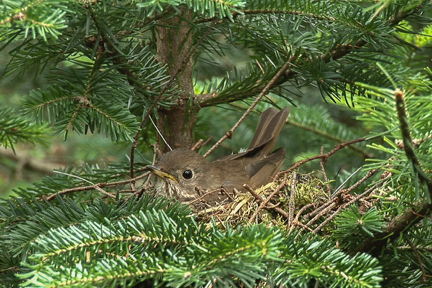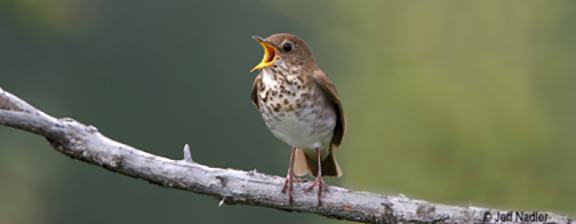Lené Gary, General Science editor
“You must have the bird in your heart before you can find it in the bush.”
– John Burroughs
While that might be true, unless you’re planning a trip to the Greater Antilles, you won’t have much luck finding Bicknell’s Thrush in a bush right now. That’s because this rare, brownish-gray songbird, smaller than a cardinal and blessed with a spiraling, flute-like song, is on its way to warmer climes for the winter.
But it will return (or so we hope). In spring, it will find its way back to wind-swept mountain ridges, maritime forests, and patches of industrial logging land to breed. Each of these landscapes has one thing in common: thick balsam fir-spruce forests. What’s beginning to disappear is the bird.
According to the May 2017 Conservation Action Plan for Bicknell’s Thrush written and released by the International Bicknell’s Thrush Conservation Group (IBTCG),New Brunswick saw an 11.5% annual decline in the bird’s breeding population between 2002 and 2011. Similar figures aren’t available for Nova Scotia. The reason the IBTCG gives for the lack of data: it’s likely there were too few survey routes.
Bicknell’s Thrush is difficult to study. There are fewer than 120,000 individuals globally, and they prefer harsh environments at high elevations or in maritime areas. They are extremely elusive. Dr. Emily McKinnon, a bird biologist who studied Bicknell’s Thrush for her Master of Science degree at the University of New Brunswick in Fredericton, told me that it took her two years to locate just ten Bicknell’s Thrush nests.
Even ten nests sounds hopeful, when you consider that entire breeding populations of Bicknell’s Thrush are disappearing. Local extinction has been documented on Mt. Greylock, Massachusetts and in isolated areas of Nova Scotia and New Brunswick.
The reason for the disappearances of some populations and the decline of others is not clear, although the IBTCG reiterates in their updated Conservation Action Plan the three primary threats facing Bicknell’s Thrush: clearing and burning of forests in the Dominican Republic and Haiti for agricultural fields; incompatible forestry practices in Canada; and climate change.
Considering that climate change is expected to displace populations further north and to higher elevations, and that the majority of Bicknell’s Thrushes nest just south of the Canadian border in New York, Vermont, New Hampshire, and Maine, there’s good reason to address “incompatible forestry practices in Canada.”

Nesting Bicknell’s Thrush. Image © K.P. McFarland, used with permission
And that’s exactly what Dr. McKinnon did. From 2007 to 2010, she and her colleagues analyzed plant composition and structure in 5-m-radius areas around Bicknell’s nests to better understand how pre-commercial thinning (PCT) might influence Bicknell’s Thrush habitat. Forest industries use PCT to manually reduce stem densities and allow the remaining trees to grow larger. The reason this matters is that Bicknell’s Thrush prefers very dense balsam fir forests, the kind that regenerate following large natural disturbances such as fire or blowdowns, or in the case of managed forests, clear-cutting.
McKinnon’s team found that Bicknell’s Thrush was most abundant in the stands that were 11–13 years old, which, unfortunately, is the ideal time for PCT. When stands are pre-thinned, the density of stems is reduced from approximately 40,000 stems/ha to about 6,000 stems/ha. Based on their findings, McKinnon and her team suggested that small patches of dense balsam fir be allowed to remain within thinned areas.

Bicknell’s Thrush chicks begging. Mt. Mansfield, Vermont. Image © K.P. McFarland, used with permission
The good news is that researchers in Vermont found Bicknell’s Thrush need as little as 0.1 ha of un-thinned forest for nesting. That means logging companies don’t have to set a lot of land aside to support this vulnerable songbird. It also means that just by the nature of logging, some thick balsam fir patches large enough to support these birds will remain because, for safety reasons, foresters tend to avoid areas with boulders, steep grades, standing water, or large dead snags.
Even though McKinnon is no longer working on Bicknell’s Thrush research, she keeps in touch with her colleagues in the field. From what she can tell, all parties are still on board with protecting this little bird’s habitat.
And it seemed, when I spoke to her, that there’s also something puzzling going on. “The habitat is there. The birds are not,” McKinnon said.
The reason for this remains elusive, but there are hints. Christopher Rimmer and Kent McFarland, scientists with the Vermont Center for Ecostudies, in their Twenty-year retrospective, enumerated the many threats still facing Bicknell’s Thrush. Besides PCT, these include fragmented breeding grounds due to ski areas, cell towers, and wind turbines; a warming climate; high mercury levels in the blood and feathers of every thrush sampled; and the birds’ disappearing winter habitat.
As is so often the case, more research is needed. But, they wrote, “Twenty years after our initial foray into the realm of Bicknell’s Thrush, one conclusion is clear. We humans have stacked the deck decidedly against this globally rare and vulnerable species”.
My conversation with McKinnon had been lively and quick-paced until she mentioned the missing birds, making her brief pause of reflection all the more poignant. This was a woman who had painstakingly studied ten nests over two years, had watched a mother dutifully sit on eggs that never hatched, had mist-netted and backpacked a bird that was banded before her study began and cheered its return the next spring.
This was a woman willing to live in logging camps, a woman who greeted the rising sun with appreciation every day for two months straight while living in the field. This is a woman whose main desire is “to help the birds. To help them persist.”
She closed her reflection with what makes her most sad when talking to people about Bicknell’s Thrush: “These little pips in Canada are blinking out.”
Help monitor Bicknell’s Thrush populations:
In Canadian Maritimes, join the High Elevation Landbird Program.
In Quebec, join Regroupement QuébecOiseaux.
–30–
Banner image by Jeff Nadler




